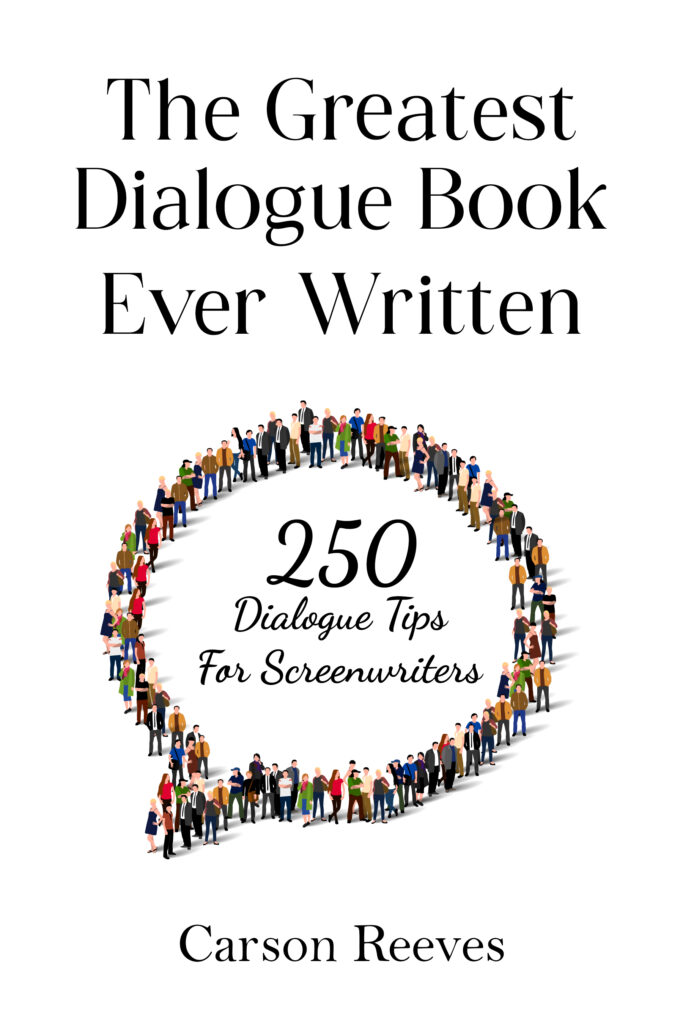Search Results for: star wars week
For those just tuning in, it’s a Theme Week. This week’s theme is great movies that tell their stories unconventionally. The idea will be to try and break down why, even though the scripts bucked traditional structure, they still worked. Yesterday, Roger led us with Kick-Ass, and today, I’m taking on a little independent film you might have heard of called Star Wars.
Genre: Sci-fi Fantasy
Premise: Luke Skywalker leaves his home planet, teams up with other rebels, and tries to save Princess Leia from the evil clutches of Darth Vader.
About: One of my favorite movies of all time. I still watch it a few times a year. Although George Lucas is the sole credited writer on Star Wars, everybody knows he had a lot of help with this script. For proof of this, go watch any of the prequels to see what happens when no one helps George. This is also why I say “they” a lot when referring to the writers.
Writer: George Lucas

Before I go into my review, let me explain a little bit about my approach to this week. Every script, like a figure skating routine, has a degree of difficulty to it. The closer you stay to basic dramatic structure, the lower the degree of difficulty is. So the most basic dramatic story, the easiest degree of difficulty, is the standard: Character wants something badly and he tries to get it. That’s all. “Taken” is the perfect example. Liam Neeson wants to save his daughter. So he tries to. Indiana Jones wants to find the Ark of The Covenant. So he tries to. Rocky wants to fight Apollo Creed. So he trains to. As you can see, these stories are simple but can still be very powerful.
Each element you add or variable you change that strays from this basic structure increases the degree of difficulty and requires the requisite amount of skill to pull off. If a character does not have a clear cut goal, such as Dustin Hoffman’s character in The Graduate for example, that increases the degree of difficulty. If there are three protagonists instead of one, such as in L.A. Confidential, that increases the degree of difficulty. If you’re telling a story in reverse such as Memento or jumping backwards and forwards in time such as in Slumdog Millionaire, these things increase the degree of difficulty.
I bring this up because all four of the movies/scripts I plan to review this week have very high degrees of difficulty and I’d like to break down how these stories deviate from the basic formula yet still manage to work. We’ll start with one of my favorite movies of all time, Star Wars. Star Wars looks like a simple story from the outside, but this quirky adventure film is actually extremely complicated, and it’s a minor miracle that the story works at all.
Degree of Difficulty: 5 (out of 5)
Why the degree of difficulty is so high:
We’ll start with how Star Wars approaches the single most basic element of the story: the character goal. Unlike how the goal would be presented in a traditional story (Shrek’s goal is to bring back the princess to retain his swamp) Lucas gives his central story goal to a trash-can shaped robot named R2-D2 who speaks a language the audience doesn’t understand. R2-D2 has the Death Star plans inside his “rusty innards” and is trying to get them to Obi-Wan Kenobi so Obi-Wan can get them to Leia’s stepfather so that they can destroy the Death Star. Hence, R2-D2, not our hero Luke Skywalker, is driving the story.
Now here’s the thing. WE DON’T KNOW THIS YET. We know that R2 has the plans to the Death Star, but we don’t know that these plans will allow the Rebels to pull off the ultimate goal, which is to destroy the Death Star. That information isn’t given to us until roughly 20 minutes before the movie ends, which makes the ultimate goal one giant shrouded mystery. But this mystery isn’t one of those “we’re dying to find out” mysteries. It’s kept under wraps only because the writers don’t want us to know it yet. That means during the majority of Star Wars’ running time, we’re not even sure what we’re going through all this trouble for.

So you have a main goal that’s a mystery being driven by a non-human character who doesn’t speak. Yeah, try to throw that into your next screenplay. But what’s even more fascinating is how this affects the other characters in the script. Because R2 is driving the story, all the other characters are following him. That means all your protagonists are passive. They’re lemmings, following a random robot wherever he wants to go. Again, you’d be called out on this in a second at a production company. (“Make your characters more proactive!” they’d say.)
So why in the world are we interested in all this nonsense? I’ll get to that in a second. But first, we must deal with one of the most outrageous script choices ever. The main character, Luke Skywalker, doesn’t arrive until 15 minutes into the movie! Every producer, manager, and agent worth their salt will tell you that by 15 minutes time, we should not only have introduced the main character, but we should understand what he’s about, what his central character flaw is, and what he’s after. This late arrival forces us to spend the next 20 minutes learning about Luke Skywalker, and the story is essentially put on hold while we do.
Further complicating matters is that Star Wars makes the decision to jump back and forth between the good guys and the bad guys, creating multiple subplots that must be kept track of ON TOP of an already complicated story and structure. And, oh yeah, did I mention that this entire story is piggybacking on top of a completely made up universe with complicated made-up mythology which Lucas must familiarize the audience with? And that he must move the story along at a quick enough pace that the script doesn’t get bogged down in all the necessary exposition to explain that universe? I mean Jesus Christ. Every screenwriting choice Lucas made here practically guaranteed failure.
The number one reason Star Wars worked was because of its characters. Every single big character in the movie was perfectly executed, starting with Luke Skywalker and Han Solo. While Luke was a passive protagonist for most of the movie, he was still driven. He wanted to take down the Empire. And that dogged idealistic drive helped us forget that for most of the movie he’s just following everyone else. Also, Luke’s fatal flaw, that he didn’t believe in himself, was executed to perfection via his eventual acceptance of The Force. When he decides to go it alone in the Death Star trenches, we’re so into it because we’ve been waiting for Luke to finally see in himself what we’ve seen in him all along.
On the flip-side, Han Solo was the perfect anti-hero. He was the epitome of I-play-by-my-own-rules charm. And the guy was hilarious. Never was it more evident how important a wise-cracking rogue character was than when the prequels came out. Without a Han Solo character, Star Wars never had a chance. And while Han’s fatal flaw was very simplistic – his selfishness – it is one of, if not the most memorable execution of that flaw I’ve ever seen. I mean, who didn’t want to see Han Solo crack and finally embrace the others over himself? This is why when he takes out Vader’s fighter in the end, it’s one of the only deus-ex-machina moments in film history that doesn’t feel like a cheat. They did such a good job setting up his selfishness, that finally seeing him help others over himself ended up being more important to the audience than the fact that a rogue force-less thief-for-hire somehow took out the most powerful villain in the universe with a single shot.
But, the characters can only do so much. You still need to have a compelling plot. You still need to have a story that’s driving forward, that keeps us interested, and Star Wars does this in two ways. It took me awhile to figure this out but one of the big reasons Star Wars works is because it’s one giant chase movie. One of the things I always tell you to do is use a ticking time bomb. Whenever time is running out for your characters, it adds immediacy to your story, which subsequently ups the tension, ups the stakes, ups the conflict and ups just about everything else. Because your characters need to do their jobs RIGHT NOW, the story has a continuous energy to it.
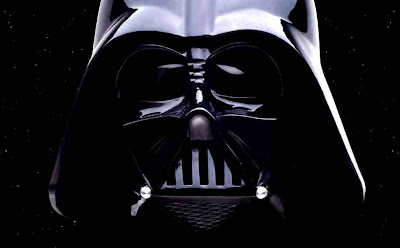
Well, a close cousin to the ticking time bomb is the chase. Why? Because it accomplishes the same thing. If your characters are being chased, then there will always be an immediacy to their actions. They always have to move move MOVE. Here, wherever our protagonists are, the Empire is close behind. From when they slaughter the jawas to when they slaughter Luke’s family to when they follow Luke and Obi-Wan to Mos Eilsley to when they’re looking for them on the Death Star… We know that they’re always RIGHT BEHIND US, and because of that immediacy, it makes us forget about a lot of the deficiencies in the storytelling (such as the hero being introduced on page 15). We’re so concerned our heroes are going to get caught, we’re not judging any of that other stuff.
Now remember when I said how it increased the degree of difficulty to jump back and forth between the bad guys and the good guys? Well this is why they did it. Since we actually SEE our bad guys, we SEE that they’re right behind the protagonists. Had Lucas not done this, had we just stayed with the protagonists the whole time, then that chase aspect wouldn’t have been nearly as effective, and the story wouldn’t have worked nearly as well.
Now here’s the thing you have to remember. No chase, no matter how short or how long, works unless we care about the characters being chased! As I mentioned before, Lucas executes all of his character development perfectly. We like all of them. Shit, we even like the damn villain! So we actually care when the Empire closes in on them. It’s also interesting to see how the successful execution of one story element (the well constructed characters) affects another (the chase). Have you ever been bored by a car chase scene? You’re not bored because the car chase is boring. You’re bored because you don’t give a shit if the characters get caught or not. Since we love these characters so much, it wouldn’t matter if they were being chased down a straight featureless hallway for 20 minutes. We’d still want to see them escape!
Another thing Star Wars does really well is it understands that its main goal is murky (the protags aren’t aware yet that destroying the Death Star is the ultimate goal). So Star Wars needs a way to keep us focused in the interim. It does this by substituting a series of smaller goals for the big one.
For example, the first mini-goal is for Darth Vadar to get down to Tatooine and find the plans. When that doesn’t pan out, his new goal is to find the droids. Next, Luke must go find a wandering R-2. Afterwards, Luke and Obi-Wan must find a ship to get off the planet. Then, Luke, Obi-Wan, and Han must deliver the plans to Leia’s father. Then, Luke, Obi-Wan, and Han must save the princess. Then Luke, Obi-Wan, Leia and Han must escape the Death Star. Each one of these goals is strong and explained ahead of time. This makes sure we’re always focused – the characters always have something they’re trying to do. If you ever get the note that your script is wandering and random, not having any immediate goals for your characters is probably why. So whenever you don’t have a clearly stated ultimate goal, it’s essential that you keep your characters busy with a series of smaller goals. Star Wars does this wonderfully.
Now of course, I could talk about Star Wars for days. I didn’t even get into the inventiveness of the Star Wars universe, the brilliance of the force, the surprises in the story, the comedy, the greatest villain of all time, etc. All of those things had a big impact on this movie being so special. But when it comes down to the quirky structure of this screenplay and why it worked, I believe the elements I listed above were the keys. It just goes to show that any story can work, even nontraditional ones, but only if you understand what rules you’ve broken, and have the requisite tools to make up for those choices.
[ ] What the hell did I just read?
[ ] wasn’t for me
[ ] worth the read
[ ] impressive
[x] genius
What I learned: Star Wars is the movie where I learned the power of the chase. Imagine for a second Star Wars without the Empire chasing the heroes. Or, if that’s too dramatic, imagine never cutting to the antagonists in the story. Let’s say that Luke and the crew were trying to deliver Artoo to Leia’s father and just occasionally ran into bad guys now and then. This movie’s high energy is due in large part to The Empire always being on their heels. If you’re writing any kind of story where your characters are on the move, you should probably have some bad guys chasing them. And if it works to cut to those bad guys, even better.
Also, you’ve got ONE WEEK left to enter The Tagline Showdown! Details Below.
The Greatest Dialogue Book Ever Written is a quick read and will revolutionize your dialogue. If you’ve EVER received notes on your screenplay like, “Your dialogue is too on-the-nose,” “There’s way too much exposition in this script,” or “Your dialogue is too bland,” then you need to buy this book right now. Honestly, just ten of the tips in this book are going to put you ahead of 75% of other screenwriters. To think you get 240 more AFTER that? I mean, come on, it’s the deal of the century. So head over to Amazon and grab it!
Also, don’t forget that we have Logline Showdown coming up at the end of next week. So get your entries in. I need your title, genre, logline, and also your *movie tagline*. Some notable movie taglines from the past…
“Live. Die. Repeat.” -Edge of Tomorrow
“If you see only one movie this summer . . . see Star Wars! But if you see two movies this summer, see Austin Powers: The Spy Who Shagged Me”
“If at first you don’t succeed, lower your standards.” -Tommy Boy
“The True Story of a Real Fake” -Catch Me If You Can
What: Tagline Showdown
I need your: Title, Genre, Logline, and Movie Tagline
Competition Date: Friday, April 26th
Deadline: Thursday, April 25th, 10pm Pacific Time
Where: Send your submissions to carsonreeves3@gmail.com
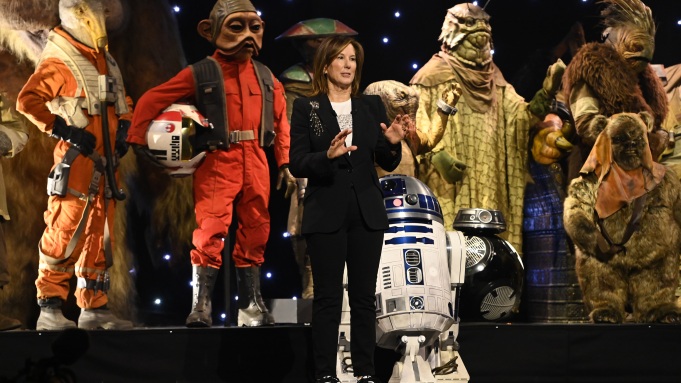
HAPPY EASTER EVERYBODY!
Just as Jesus was resurrected on this day, so is my Star Wars frustration!
One of the more toxic trends I’ve seen lately is this act of making money off of complaining about franchises, Star Wars being one of the biggest examples. These complaining videos started out genuine. They were people who loved Star Wars voicing their frustrations over the questionable choices Lucasfilm was making. But what happened, unexpectedly, was the channels became gigantic financial successes and everyone realized you could make a lot of money complaining about big franchises.
It’s quite ironic, this cottage industry of hate-mongering, as one of their biggest criticisms is that Disney and Lucasfilm have all these shills propping up Star Wars when it doesn’t deserve it. Yet if you look through the history of these posters, their videos all read the same, “Star Wars is Dead,” “Mandalorian Worse Ratings than Rings of Power!” “How Grogu Became Nothing But a Meme.” “Kathleen Kennedy Hates You.” These Youtubers would never post a positive review because positive reviews aren’t on brand and, therefore, don’t make them money. So they’ve become just as untrustworthy.
The problem with this Evil Empire of Criticism is that it’s made talking about the very real problems that Star Wars has difficult. Cause people just assume you’re one of the for-profit haters. It allows Lucasfilm to protect itself against real introspection. If they can paint every negative critique as disingenuous, they don’t have to look inside themselves.
For those who don’t know, Star Wars had their official Star Wars Celebration this weekend where they announced three new movies. The weekend had a bit of “gun to the head” feel to it. Kathleen Kennedy has done everything in her power to avoid announcing a Star Wars feature film slate due to the PTSD she’s suffered from the recent trilogy. But she had to announce something this weekend. And this is what we got:
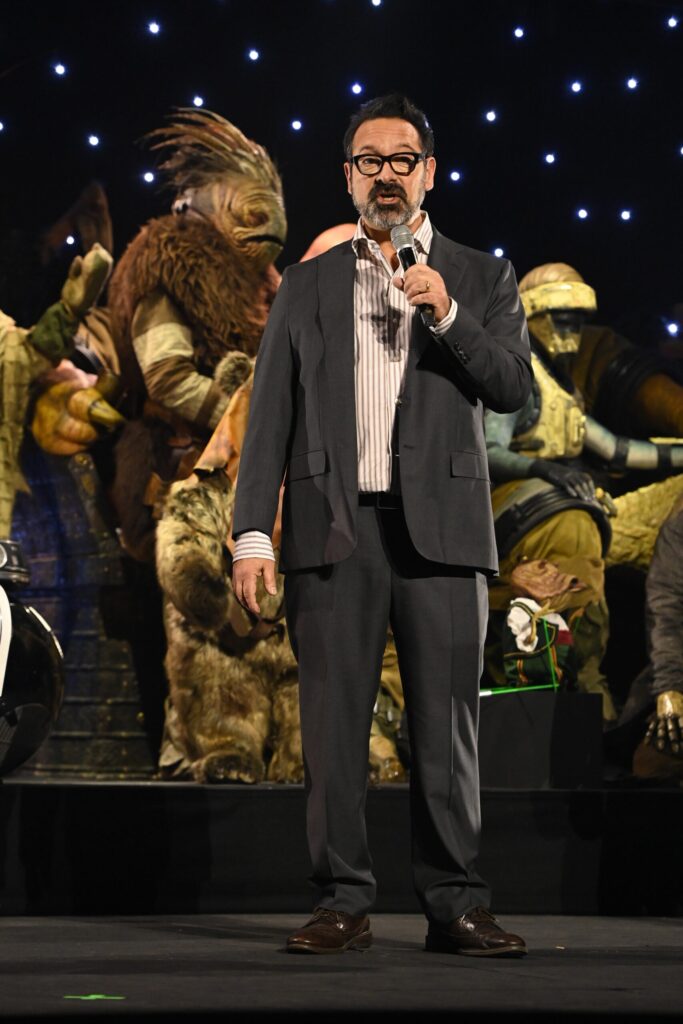
James Mangold Film – Of the three films announced, this one has the most potential. It’s about the birth of the very first Jedi, set 25,000 years before Star Wars. We’ve never explored that far back in the Star Wars universe, which allows for some really unique possibilities. Just the way you design that universe could allow for a Star Wars film that looks and feels different from anything we’ve seen before. Mangold, who’s best known in nerd circles for directing Wolverine, says that his movie is inspired by Ben-Hur. So it’s going to have major religious undertones, which makes sense considering it’s about The Force. Lucasfilm just made the latest Indiana Jones film with Mangold. This would imply that they’re happy with him. However, there is one thing that worries me. If Indiana Jones doesn’t do well – which is a real possibility considering it features an 80 year old action star (I know, I know, 80 is the new 40) – this film probably won’t get made. We know that from what happened to Patty Jenkins after Wonder Woman 1984, Colin Trevorrow after The Book of Henry, and Taika Waititi after Thor: Love and Thunder (I know Taika’s movie is supposedly still in development but the fact that it has no script yet after two years tells me it’s probably not happening).
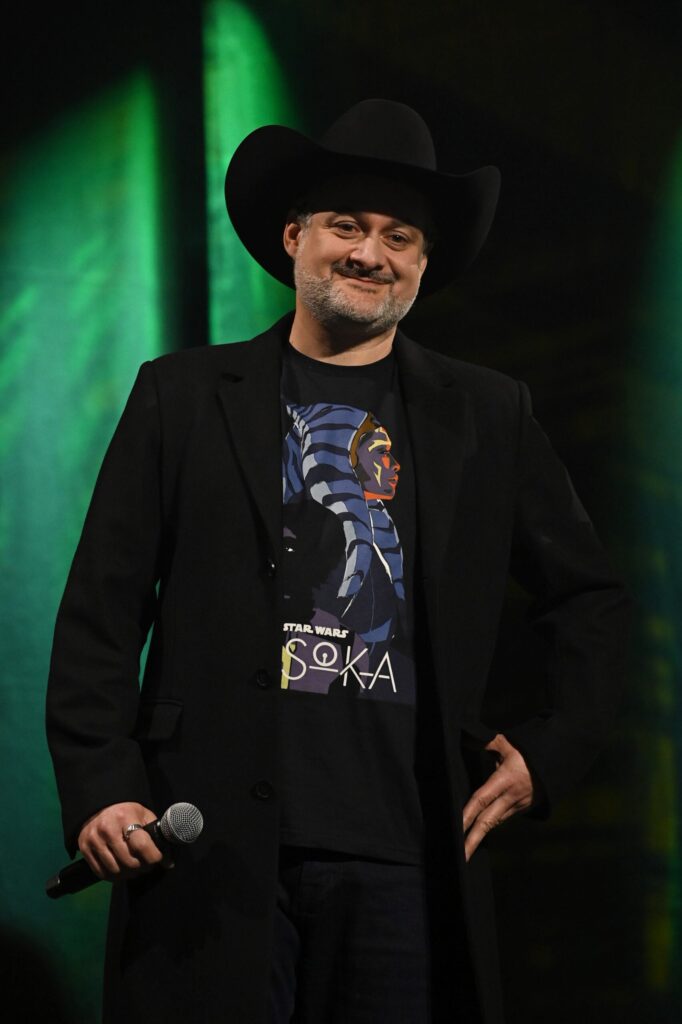
Dave Filoni Film – What Dave Filoni is great at is animated storytelling. His child-like sensibilities and basic storytelling skills are perfect for a non-discerning audience such as 10 year olds and ultra-hardcore Star Wars fans who will eat up anything the franchise serves them. Which is why his Rebels show is so popular. But the niche world of animated TV is a completely different ballgame compared to the feature film world. The stakes in feature films have to be gigantic. The characters have to be bigger, more grounded, and have more depth. The plot and pacing need an 8 cylinder engine running underneath them at all times. I just don’t see those skills in Filoni. I see him as someone who loves Star Wars and loves to – successfully I may add – incorporate deep-cut characters into the universe in fun ways. But those skills mean nothing in a feature film. So I was concerned when Filoni’s project was announced. But then I heard that his movie is going to be a culmination of all of the Star Wars shows (Mandalorian, Ahsoka, Boba Fett). And what that tells me is that it’s going to be a Disney Plus TV exclusive. They did not announce that. That’s my own assumption. But it makes sense. This allows Filoni to play in this bigger higher-stakes sandbox to see if he’s got the chops to be there without putting a ridiculous amount of money and resources on the line. A Disney Plus exclusive Star Wars movie is literally perfect for Filoni. And look, if he knocks it out of the park, by all means, give him a real feature film.
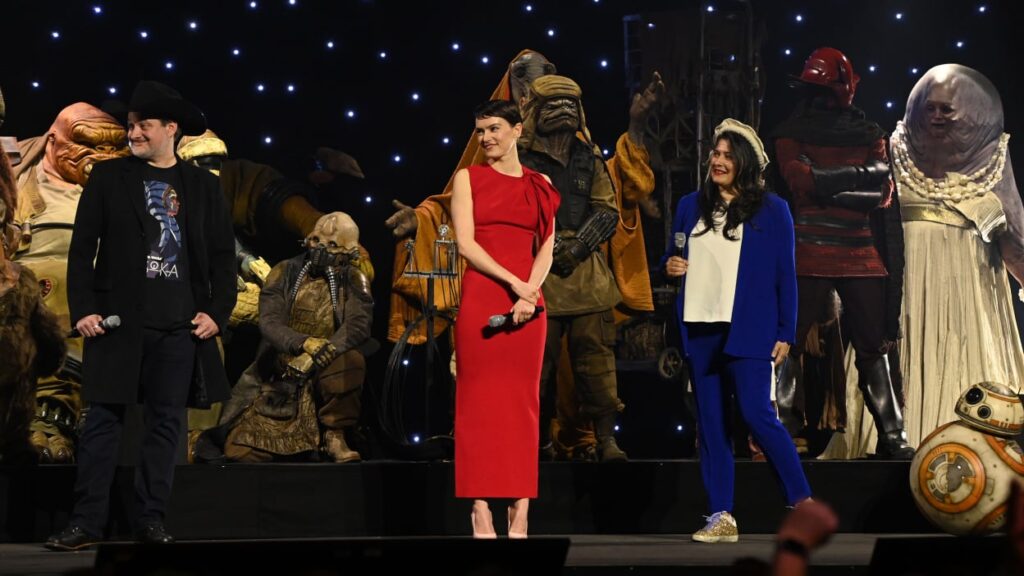
Rey Film – This project is the one that not only shocked me, but shocked the world. Rey is a barely above average character. And she’s just come off a trilogy that left a bad taste in peoples’ mouths. By the way, this is the project Damon Lindelof just left. In his classic self-deprecating manner, Lindelof said it was because he just couldn’t write a good enough script. But what he really seemed to be saying was, “I’m not sure this is a story worth telling.” The project is being directed by Sharmeen Obaid-Chinoy, a director who wasn’t even the best director on the fourth best Marvel TV show. If you’re going to give a Star Wars movie to a director from Ms. Marvel, give it to Adil El Arbi and Bilall Fallah! Their pilot episode to that show was awesome! The only way I see this movie succeeding is if they bring back Kylo Ren. Rey becomes infinitely more interesting when he’s around. I know he just died. But what does death even mean in movies these days? But I could see a potentially fun movie if Rey and Kylo were teamed up.
Regardless of whether you agree or disagree with my assessments of the trio of announced projects, one thing was very clear about the celebration: Kennedy is unsure of herself. Even the fact that they’re only announcing one Rey movie, as opposed to a trilogy, which is standard procedure – that indicates how gun-shy she is. And that, more than anything, is what makes me skeptical that we’ll see all of these films. Filoni’s film is supposedly 5 years down the line. So much can change in that time period. Will there even be a Disney Plus?
As a Star Wars mega-fan whose love for the franchise has been waning as of late, I know something needs to change. But I don’t know what. There’s some indescribable magic to the formula George Lucas brought to the table that seems to be harder to replicate than we thought. There have been low-key rumors that Lucas is coming back into the mix in some way. That’s probably the smartest move Lucasfilm could make right now. Bring back those weird ideas he had for Episodes 7-9 and reimagine them for the next wave of films. If you really wanted the fandom back on your side, that’s the move you would make.
Remember to sign up for David Aaron Cohen’s “the business of screenwriting” class where you learn how to get an agent, how to navigate TV writers’ rooms, how to deal with producers and their notes, how to pitch, and much much more. The class is already half full in just a weekend. Slots will continue to fill up quickly. Check out the bottom of this post to get your big $300 Scriptshadow discount!
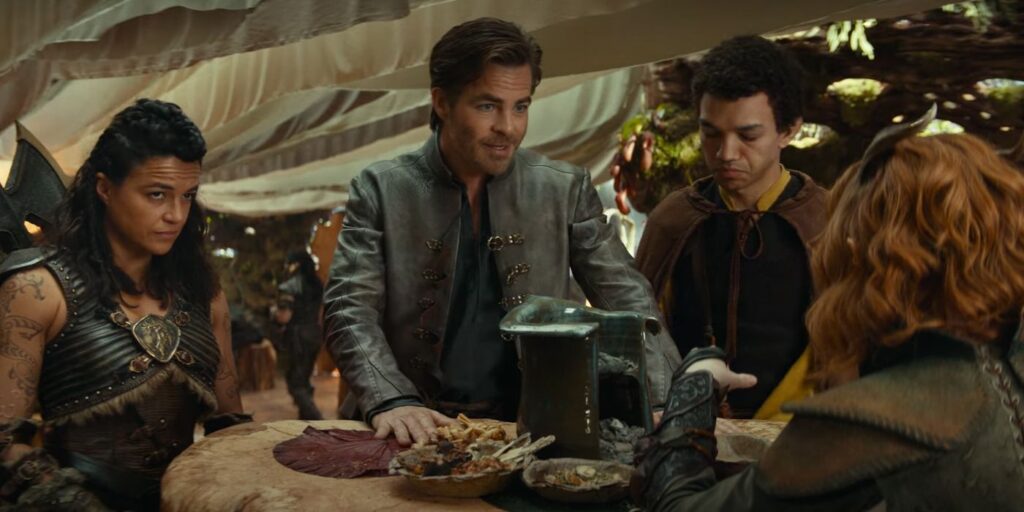
I’m always looking for that screenwriting angle to an industry story.
So when I see that Dungeons and Dragons couldn’t quite manage 40 million dollars on its opening weekend in an industry where big-budget films need to make 60 million dollars *AT LEAST* to be considered a success, I ask, “What can we learn from this?”
Or when I see that last weekend’s belle of the ball, John Wick 4, dropped a significant 62% in its second weekend (John Wick 3 dropped only 56% in its second weekend), I openly wonder, “Is there a writing issue here?”
Let’s start with Dungeons and Dragons. I don’t think it matters what you do with this property – it’s not going to work. The primary problem is, when I say, “Dungeons and Dragons” and ask you what images come to mind, I’m guessing the answer is “nothing.” Because it’s not like Star Wars where you immediately think of lightsabers. Or Lord of the Rings where you have clear images in your head of creatures like Gollum. Or Marvel, where you imagine a dozen different superheroes.
Dungeons and Dragons literally makes you think of a generic looking dragon. Or a generic looking cave. Or a generic looking orc. There’s no specific imagery. And specific imagery is what sets IP apart from original ideas. If I pitch you a Peter Pan movie, that’s going to put a specific image in your mind, compared to if I pitch you a Flyborne Felix movie.
That makes Dungeons and Dragons one of the rare instances of IP that operates like an original idea. It’s not bringing IP value to IP. Which is the whole point of IP!
Another problem with Dungeons and Dragons is the studio’s attempt to turn it into a comedy. I know a few people who play the game. I don’t personally play it. But my understanding is that it’s not a comedic game. It’s more of a strategic game that the people who love take seriously.
If superhero movies have taught us anything, it’s that the closer you draw from the source material, the better. By making the Dungeons and Dragons movie highly comedic, aren’t you moving away from the source material? Are Dungeons and Dragons players the types who say, “Man, did you hear how funny they made Dungeons and Dragons? I gotta see that. It’s such a good idea to make it funnier!” I’m guessing nobody said that.
Which goes back to the truth of the matter, which is that this isn’t a solid enough property to build a franchise on. It just isn’t. And the box office bore this reality out. That’s something every writer should be aware of: Is my idea good enough to write a script about? Because, if it isn’t, it doesn’t matter how good your execution is. It doesn’t matter what your angle is. Your idea was never strong enough to support a feature film.
Which is why I can complain about how Dungeons and Dragons shouldn’t have been so comedic but I know that even if they’d gone the serious route, it was still going to tank. Cause it’s built on top of a weak foundation. There’s not a single recognizable character or creature here. So it’s not surprising that D&D, like its predecessor in 2000, will fade into the night, never to be remembered again.
Our second big movie lesson comes from John Wick 4’s big second weekend dip. A 62% drop isn’t as bad as Quantumania’s 70% drop. But like I said above, it’s a fairly significant drop compared to the third film, and this from a movie that’s gotten a lot more attention. So what’s going on here?
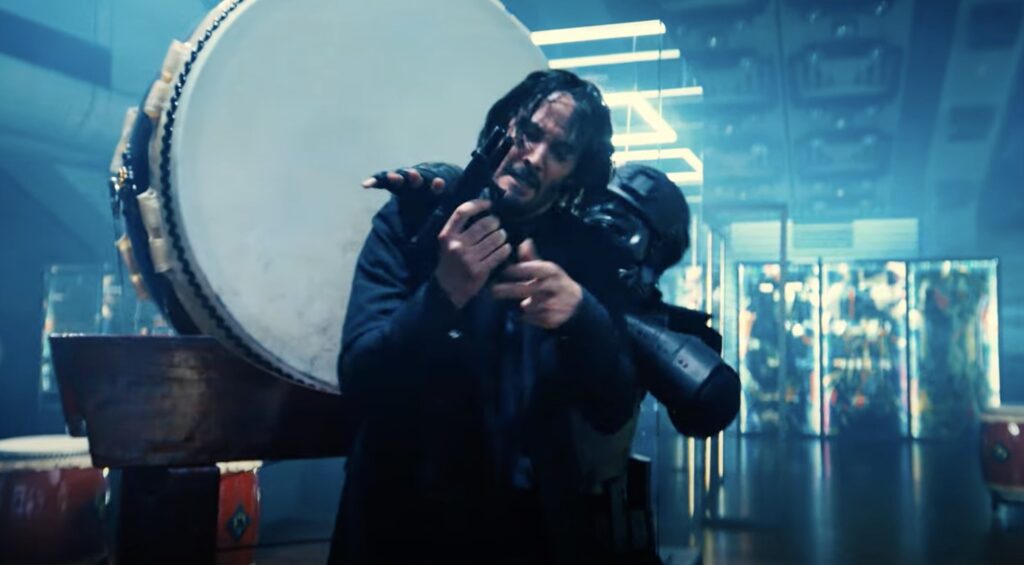 No, you are not experiencing deja-vu. This move is happening for the 980th time this movie.
No, you are not experiencing deja-vu. This move is happening for the 980th time this movie.
At first I thought it was the length. That’s what she said. But Avatar 2 and its 9-hour running time becoming one of the highest grossing movies ever put that theory to rest. But I do think time is a part of the problem, specifically REPETITION. This is something I see all the time in weak scripts, which is the repetition of things we’ve already seen.
John Wick’s biggest weakness is its insistence on fighting and shootouts that repeat the same moment over and over again. I mean, how many times did we see John Wick grapple with someone, shoot him a few times, kick and punch, before taking them down and shooting them to death. There literally had to be 75 kills that played out in the exact same way.
If they would’ve cut those in half, not only is the movie going to move faster, but the kills then take on more significance, since the rarer something is, the more valuable it is.
For any movie, the opening box office of the film is based on five things – the concept, the directing, the IP, the marketing, and the cast. But the second weekend is based on one thing: THE WRITING. If the writing is good, everybody who saw your movie on that opening weekend will tell their friends and talk it up on social media. That’s when you get small second weekend drops. If you get a big dip, the issue is the writing.
This is not surprising for the John Wick universe, as this property has never been about the writing. Even John Wick is more of a movie star persona (Keanu Reeves) than a character. We don’t really know anything about John Wick other than he likes to shoot guns. He’s similar to Ethan Hunt in Mission Impossible. The average person who watches Mission Impossible doesn’t even know Ethan Hunt’s name. They know him as Tom Cruise.
Movie star driven movies can work. I’m not bashing them. The problem becomes when you rest on that and don’t think you need to write as good of a script because of it. A lot of these big movies fall into that trap. John Wick 4 dropped the ball there. They became so obsessed with the production design and the fighting choreography that no one thought to say, “Hey, maybe we shouldn’t have 6000 fights that look exactly the same.”
Cause I’ll be honest with you. I almost didn’t give John Wick 4 a passing grade. Specifically because it was so much of the same moment over and over.
The good news is, we’ve got “Air” coming up next weekend. It’s a great script that broke into my Top 25. The movie’s supposed to be just as good as the screenplay. Previously, I only had the review inside a newsletter. But for those who don’t receive my newsletter (e-mail carsonreeves1@gmail.com with subject line: NEWSLETTER to sign up) I’m including the review below, when the script was titled, “Air Jordan.”
Genre: Sports Drama
Premise: In 1984, an out-of-shape bulldog of a sports executive at a small shoe company called Nike attempts to sign the hottest basketball player out of college, Michael Jordan.
About: This is that big splashy deal that just came together. Ben Affleck will direct (and star). Matt Damon will star. Amazon is the buyer. This is a huge win for the writer, Alex Convery, who doesn’t even have a produced credit yet. I’ve reviewed a couple of his scripts, Bag Man and Excelsior, both of which I liked. So this guy’s got the goods. No doubt this project came together in the wake of the success of HBO’s Winning Time.
Writer: Alex Convery
Details: 104 pages.
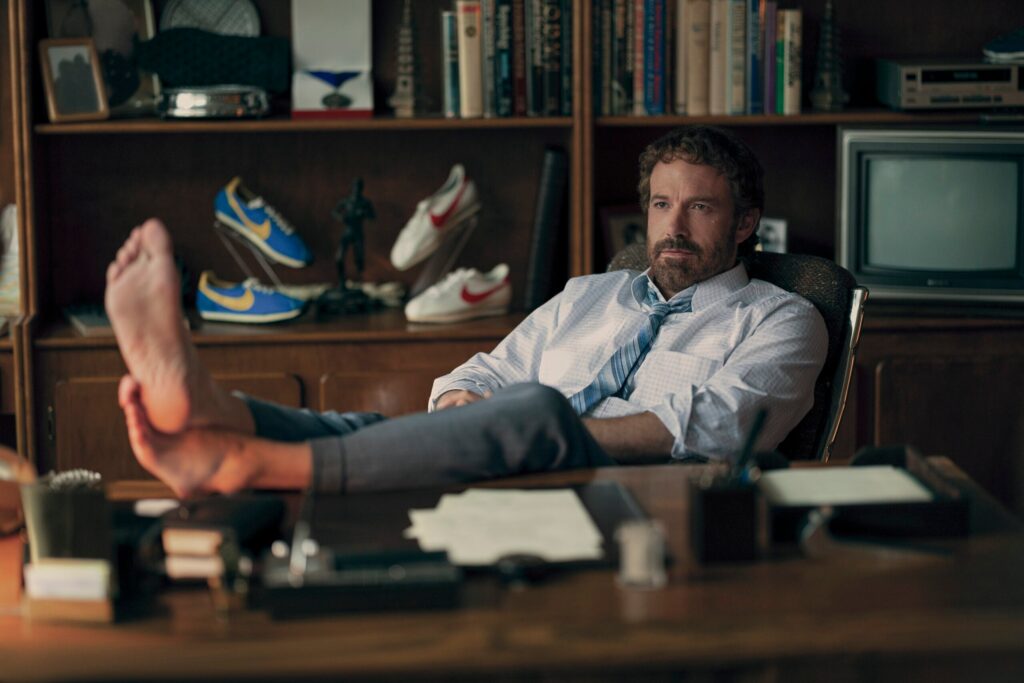
As someone who grew up in Chicago during the Jordan era and who used to routinely go to the old Chicago Stadium to watch the Bulls play, I can say that I am both excited and not so excited for this script.
I’m excited because I get to go back in time and relive some powerful memories. I’m not excited because I’m not convinced there’s a story to tell here. When you’re going so deep into the Jordan mythology that you’re covering some orbiter of an orbiter of Jordan’s sun, you’re testing the limits of what people care about. I mean, what’s next? The story of Cher’s first hairdresser’s assistant?
Then again, isn’t that all scripts? You don’t care until you do. Let’s see if we do!
45 year old slovenly Italian-American Nike shoe executive Sonny Vaccaro is looking at an uncertain future. He works in the basketball department for Nike, a tiny shoe company that specializes almost exclusively in its CEO’s first love, running.
In 1984, Nike doesn’t care about basketball because nobody cares about basketball. The NBA championship isn’t even broadcast live! So it makes sense why Sonny’s boss, Phil Knight, is only giving the basketball department 250,000 dollars to sign three rookie basketball players to shoe deals.
Now you have to understand, back then, there was no such thing as a personalized shoe. You wore whatever shoes the companies made. And Adidas and Converse had much cooler shoes than anything Nike had created.
While the rest of his team is resigned to signing scrub basketball players, Sonny is obsessed with getting Michael Jordan, a huge problem because Phil won’t give him the money to sign him and Jordan’s agent, David Falk, says Jordan doesn’t even want to meet with Nike. He’s set on Adidas.
This is when Sonny has his epiphany: A PERSONALIZED shoe built around the player. They’re going to mold it to his foot. They’re going to design it the way he wants it designed. And they’re going to give it a name – Air Jordan – that will work to market him while he’s playing.
Now all Sonny has to do is figure out a way to get in front of Jordan and make his pitch. When all avenues fail, Sonny heads out to North Carolina to talk to Jordan’s parents. Used to slimy tactics from agents and executives at this point, they don’t want any part of Sonny. But while Sonny can’t dunk from the free throw line, he does have a superpower of his own: HE NEVER STOPS TRYING. And he will pursue Jordan til the bitter end.
The first thing that comes to mind when I read a script like this is a rarely talked about writing tool, which is audience dramatic irony. Traditional dramatic irony is when the audience knows something the main character does not. Audience dramatic irony is when the audience knows more than every single character in the story. Titanic is an example. We know the ship is sinking. They don’t.
Audience dramatic irony can be played to all sorts of effect and is perfect for scripts like this, where the audience already knows a bunch of details. For example, there’s an ongoing discussion within Nike on whether Michael Jordan is worth spending their entire basketball budget of 250,000 dollars on. We, of course, know that Michael Jordan will be worth billions of dollars to Nike in the future. So it’s funny to watch them squabbling over such a minuscule number.
Or you get moments like Sonny meeting with the general manager of the Portland Trailblazers, who infamously passed on Michael Jordan with the number one pick (The Chicago Bulls would end up picking him at number 3). Sonny is trying to figure out from the guy why he passed on Jordan, try to get a little intel to help him decide what to do. After a while, the GM gets annoyed with Sonny’s line of questioning and says, “What, you think I’m going to be remembered as the man who passed on Michael Jordan? Come on, Sonny. Players come and go. No one’s remembered for just one player.”
But the big reason this script works and the reason it will be a hit is because of one of the most basic screenwriting principles in the book – IT’S GOT A MAIN CHARACTER WHO WANTS SOMETHING REALLY BADLY AND HE GOES AFTER IT WITH ALL HE’S GOT.
This whole script is about a guy determined to get something – sign Jordan. That’s it. We always feel like we’re moving forward because every interaction Sonny has is for that larger goal. This is when scripts really cook, when you institute this simple principle. It’s when characters have muddled motivations and don’t really care about what they’re after that scripts become boring (later Scriptshadow Edit: look no further than the third season of The Mandalorian).
Once you establish that drive to succeed, you simply make succeeding as hard as possible. Sonny’s boss, Phil Knight, won’t give him the budget he needs to sign Jordan. Jordan’s agent, David Falk, tells him don’t even try. Jordan’s signing with Adidas. Jordan’s parents tell Sonny, “He’s not going to sign with you. Give up.”
What readers and audiences like is determined characters going up against giant “no’s” who then overcome those no’s one by one. The reason audiences connect so closely with this formula is because most people in life get beaten down by obstacles. At a certain point, they give up. So to see someone not give up is wish-fulfilling and life-affirming. Because they say, “Well, this guy can do it. Why can’t I?” And they leave that script or that movie charged up.
An ancillary benefit of this is that many of your scenes will write themselves. Think about it. You have a guy who needs something badly. You have a line of characters who want to keep him from getting it. This ensures that EVERY SINGLE SCENE is set up to succeed. Because the best scenes tend to be when someone wants something and someone else doesn’t want to give it to them. Writers do mental cartwheels trying to find scenarios that will allow them to use this formula in as many scenes as possible. However, when it’s baked into the premise, like it is with “Air Jordan,” you just show up for the scene “room” and the chairs and tables have already been arranged for you.
It’s also a really fast script to read because it’s all dialogue. And this is something I tell writers all the time: If you’re good at dialogue, write scripts where all anybody does is talk because those scripts read the fastest. And “a fast read” is crack to a busy industry person.
I tried reading a professional script the other day and it was like walking through quicksand with boots made of concrete getting through those pages as it was all really dull and elongated description. This is the opposite. Every scene is the dialogue-friendly character of Sonny walking into a room and trying to convince another character of something.
Totally see why Matt and Ben fell in love with this. Air Jordan is a slam dunk.
[ ] What the hell did I just read?
[ ] wasn’t for me
[xx] worth the read
[ ] impressive
[ ] genius
What I learned: Strike when you’ve got a screenplay that exists in the same world as something that’s hot right now. A script about otters is dead in the water until, one day, a movie about beavers clears 100 million in its first weekend at the box office. Air Jordan, no doubt, started getting pushed heavily around town once the documentary, Winning Time, became a hit. If you’ve got anything that’s similar to a movie or show that everyone’s talking about, call every contact you know, no matter how peripheral, and pitch your script to them. If it’s anything close to that hot new successful thing, they’ll want to read it.
What I learned 2: For the really savvy screenwriter, track shows that are similar to your idea BEFORE THEY GET ON AIR. You are waiting for them to do well so that when they do, you have already lined up your ducks. I bet my Jordan memories that’s what happened here. They saw that Winning Time was coming out and built a campaign around sending that script to everyone once the buzz for the show ratcheted up. You’re playing with the big boys here. Do your prep work and stay ahead of the curve.
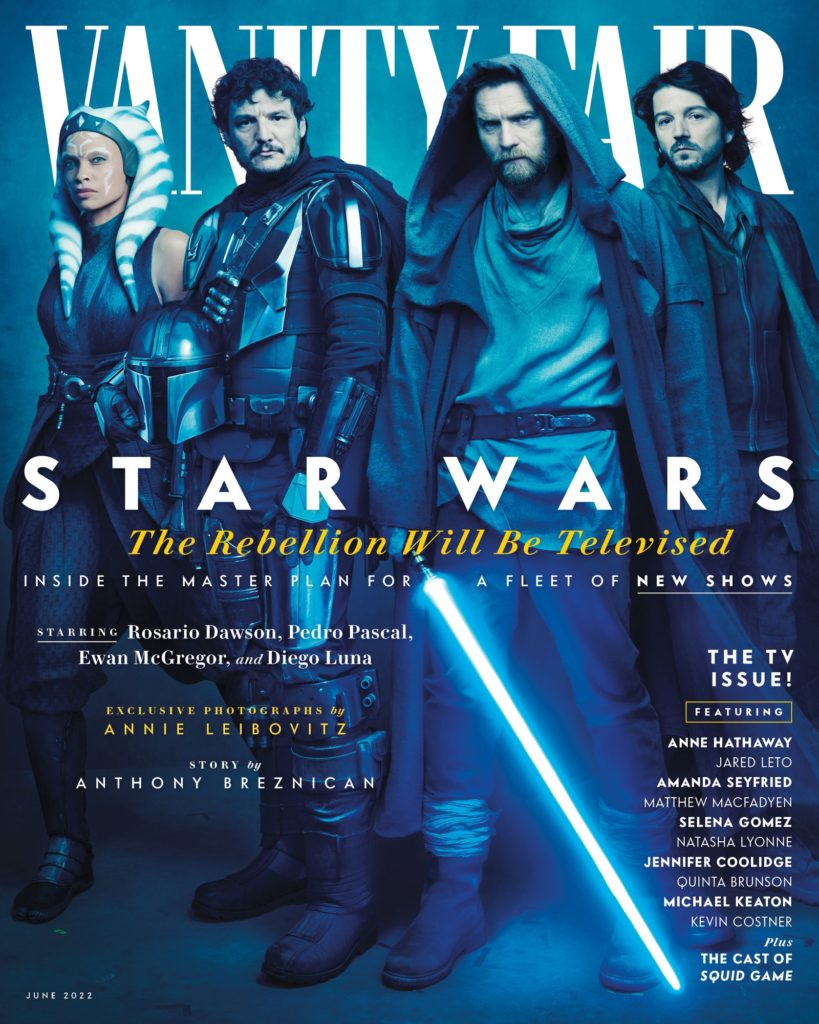
As we ramp up to next week’s debut of the Obi-Wan Kenobi show, the Star Wars heads have reluctantly started doing press to build excitement for the Disney Plus series. I say “reluctantly,” because Kathleen Kennedy hates press. She hates it because any discussion about the background workings of Star Wars will eventually lead back to her and any discussion about Kennedy ultimately shines a spotlight on the fact that she hasn’t done a very good job.
There are some who would contest this point. Four of the five Star Wars movies under her watch made over a billion dollars. And the instant success of The Mandalorian helped spawn a giant batch of new Star Wars shows for Disney Plus. But as is the case with most things, the Sith is in the specifics.
Kennedy is personally responsible for sending the new trilogy off a cliff. The fact that it ended with even a modicum of the brand still intact is a minor miracle. She chronically changes her mind, hiring and firing everyone under the sun. This has turned every established filmmaker against the Star Wars brand, which is why nobody big will touch the franchise.
We’ve gotten a new peek behind the curtain in the now annual Vanity Fair Star Wars photo shoot article. Kennedy was mostly tight-lipped, as she knows that anything she says will be seen negatively by the fans. But she did admit that recasting Harrison Ford was a mistake and seemed to imply that, moving forward, they’re going to perfect this digital likeness technology.
In addition to Kennedy’s comments, we learned that Dave Filoni was vehemently opposed to Baby Yoda. That was shocking. We also learned that Spider-Man director Jon Watts has a Goonies-like Star Wars show in development, as it will follow a group of young kids in the Star Wars universe.
All of this got me thinking about how the Star Wars brand has fared since Disney bought it. And I thought, what better way to express my thoughts about the post-Lucas era than with a list! So I’m going to rank the 20 biggest Star Wars elements since the acquisition. These include movies, shows, characters, creators, and overseers. Anything Star Wars since 2015 is in play. Read on. You might be surprised!
Note: Excuse some of the snarkiness. I get very passionate when I write about Star Wars!
20) Maz Kanata – Maz Kanata represents, ironically, just how big of a genius George Lucas was. Because when we meet a character like Yoda, we don’t question why he was made or how he was made. He just “is.” That’s how convincing the character is. But Maz Kanata shows us just how hard it is to create a weird character. There’s no roadmap to weirdness. It’s a gut feeling you go with. That’s what Lucas was a genius at. He’d put a stormtrooper on a giant lizard, riding it like a horse, and someone would ask him why he did that and he’d shrug his shoulders and say, “Ehhhhh, it’s whimsy.” The new trilogy misses Lucas’s whimsey. And the failure of Maz Kanata embodies that loss.
19) Rose Tico – There may not be a bigger example of a director not understanding the movie he’s making than the creation of Rose Tico. I know people have been trying to pretend Rose Tico is popular or something ever since the film came out. She’s not. If you ever want to see how much a Star Wars character is liked, check out the toy line. That’s where you know something is popular or unpopular. And can you get Rose Tico action figures for micro-pennies on the dollar if you want her. It was a badly conceived character. It was bad casting. Trying to fit her into a love story was a terrible decision. She didn’t work on any level.
18) Solo – I wasn’t a huge Alden Ehrenreich hater. I thought he did a pretty good job as Han Solo. The problem was he was in a movie that never felt necessary. But there were all sorts of choices that led to this film’s demise. I remember being a month out from this film’s release and there being zero awareness that it was coming out. Nobody knew. Of course you’re going to have a terrible opening weekend if nobody’s talking about a Star Wars movie a month before it comes out. Also, the film felt rushed. I remember watching it and thinking, “This looks really dark. I can’t tell exactly what’s happening.” I got the feeling that the film was so rushed, it didn’t have time to go through the proper post-production channels where they take care of stuff like that. It was just a disaster pretty much from the get-go.
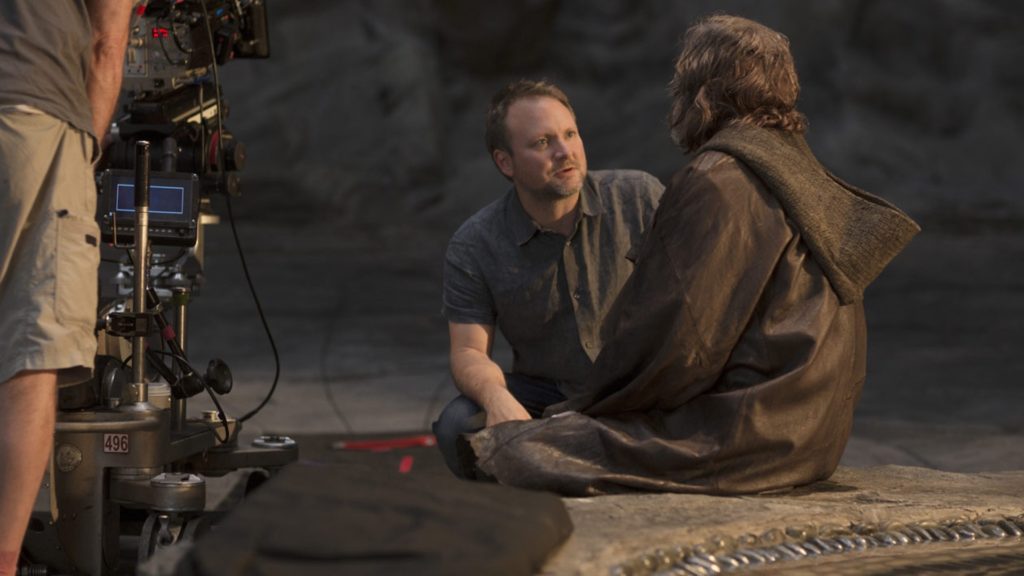
17) Rian Johnson – Rian Johnson simply never understood Star Wars. What he understood was his weird quirky indie film sensibility and he used Star Wars as a trojan horse to give one of those indie stories the big-budget treatment. The result was a couple of memorable moments, but overall, a complete misread of the mythology, which culminated in the assassination of the series’ lead character, Luke Skywalker. If that wasn’t bad enough, he gave the series nowhere to go in the final film, forcing JJ Abrams to bring back a dead bad guy. Johnson is one of the worst decisions the Star Wars brand has ever made.
16) Finn – Let’s be honest. Finn ended up being a disaster. And it didn’t help that the actor who played him, John Boyega, had a public meltdown in the middle of it all. There’s so much that went on here, it’s hard to pinpoint where the blame lies. But I think I have to blame Rian Johnson. JJ clearly had a bigger story in mind for Finn. Rian, meanwhile, had no idea what to do with him. So he forced a love story onto two characters with zero chemistry. Word on the street is that JJ wanted Finn and Rey to end up together but Disney said no because he was black. It’s up to you if you decide to believe that. But clearly all sorts of behind-the-scenes issues contributed to this character imploding. Cause he was actually kinda cool in the first film.
15) Poe Dameron, Jyn Erso – Never have two characters lacked personality more than these two. They were soooooo so so so very boring. Just writing their names down made me bored. Jyn Erso is an interesting case because word on the street is that the original performance of the character made her seem like a b*tch. So they took out all of the b*tchy moments, which is why the character seems so lifeless. Cause she wasn’t allowed to display emotion. Poe is different in that he’s a high-energy guy. So he *should* be exciting. Yet he, too, was boring. I think in JJ’s attempt to not make him a Han Solo clone, he stripped away any negative sides to Poe, and, in the process, stripped him of the duality many characters need to come across as complex.
14) Cassian Andor – Never have I seen a franchise try to push a character who didn’t deserve it more than Star Wars has tried to push this character from Rogue One. The character is weak. The actor isn’t very good in the role. Literally nothing about the character pops off the screen. And now we’re going to get an entire series of him! Talk about a weird decision. The series is being written and directed by Tony Gilroy, who’s openly admitted he doesn’t even like Star Wars! So we’re getting a show about a character nobody likes written by a guy who doesn’t like the world the character exists in. Buckle your seat belts for six episodes of bounty hunting boredom.
13) Kathleen Kennedy – You can’t completely poo-poo what Kennedy achieved. She picked the perfect director to bring the series back to life, which resulted in an unprecedented 2 billion dollar box office haul. She’s also spearheading a gigantic property that has a lot less certainty than her in-house sibling, Marvel. Those guys just have to find a popular comic run and turn it into a movie. Star Wars is much more of a guessing game. And that’s the problem. Kennedy doesn’t understand Star Wars and therefore guesses badly. I don’t know if “Solo” would’ve been a masterpiece had Lord and Miller not been fired by Kennedy. But I know for a fact it would’ve been better than that vanilla ice cream excuse of a movie they came up with. Kennedy just doesn’t “get it,” and it seems that whenever Star Wars has a hit, it’s because of someone else, not because of her.
12) Dave Filoni – I go back and forth on Filoni. I know there isn’t a bigger Star Wars fan in the universe. And I love the story of him moving up the ladder from a research assistant at Lucasfilm to directing live-action episodes of Star Wars. I can only imagine how exciting that must have been for him. Here’s my issue with Filoni though. It seems as if the only reason he got the job is because he was the only person in Lucas’s orbit who unabashedly liked the prequels. Lucas got hammered on those prequels so much that meeting someone who actually liked them created a Stepbrothers moment (“DID WE JUST BECOME BEST FRIENDS??”). From that point on, he was pretty much anointed a superstar in the company. And he could do no wrong. Therefore, even though he’s achieved great things at Lucasfilm, you still get the feeling whenever you watch one of his episodes that you’re dealing with a fanboy as opposed to a director. I’m just not convinced he has any creativity of his own. And the fact that he tried to kill the biggest thing to come out of Star Wars in 20 years – Baby Yoda – makes me even more skeptical of him.
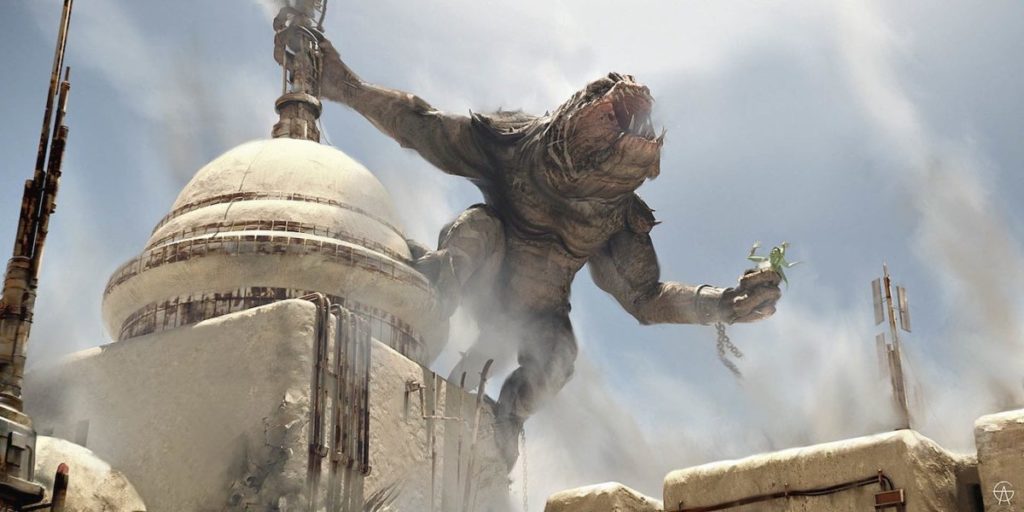
11) Boba Fett Show – Trying to consolidate my thoughts about the Boba Fett show is like trying to consolidate my thoughts about the evolution of the Sports Illustrated swimsuit issue. There’s too much to wrap my brain around. The show, at one point, DITCHED BOBA FETT! For two episodes it just said, “Byyyy-yeee” to its main character! At the same time, it gave me Jabba The Hutt’s twin cousins and Boba Fett riding a Rancor! I don’t hate this show. Yes, I do hate this show. No I don’t. Yes I do! If we’re being totally honest, I don’t think they had any idea what they were doing when they made this show. But it’s got some cool moments and that final episode was pretty darn entertaining.
10) Snoke – While I didn’t love Snoke at the outset, I began to warm up to him. And I thought some of Rian’s best stuff in Episode 8 was Snoke. Until he killed him off. I still contend that there was stuff you could’ve done with this character. I’ve always loved the idea of a crazy Sith hiding out in the Outer Rim, waiting for his moment to take over the galaxy. But Rian ruined all that. I’m guessing this is one many Star Wars fans will disagree with me on. But I always thought Snoke was pretty cool.
9) JJ Abrams – Now that I’ve had a little distance from the new trilogy, I don’t see JJ with the rose-colored glasses I did at the time. But I still think he made a fun first movie that recaptured some of the magic that had been lost in the prequels. Those early scenes of Rey struggling to survive on Jakku worked well. And JJ understood something key about the original movies, which is that they all moved quickly. I also thought he did an amazing job salvaging the franchise from the sarlac pit Rian Johnson hurled it into. That the final film was even cohesive is a testament to his understanding of story.
8) The Mandalorian (The Character) – What’s so interesting about the Mandalorian character is that he’s not very interesting on his own. How can he be? We never see his expression. And he doesn’t talk that much either. A lot of who he is is expressed through his relationship with Baby Yoda. And just the fact that he will fly to the ends of the galaxy to protect this guy makes The Mandalorian lovable. There’s still some weird stuff going on behind the scenes about Pedro Pascale not wanting to wear the helmet and that ruining the climax of the second season when he takes his helmet off (since he already took it off two episodes prior). But there’s no doubt that the character is near the top of the list in the post-Lucas Star Wars rankings.
7) Rey – I always liked Rey. I just never loved Rey. But she was a great underdog character to pin the story on in the first film. And one of the things I thought Rian Johnson did right was the sexual tension he built between Rey and Kylo in the second film. It was a good evolution of her character, and a little unexpected, especially from Captain Bad Idea. Ultimately the character’s inner journey became muddied and we weren’t really sure what she was after. I mean, yeah, she wanted to know who her parents were but since so many people kept coming in and out of the creative process, that revelation kept changing, and you could see it in the way Ridley played the character. With that said, I still think the character was a success.
6) The Mandalorian (The Show) – The Mandalorian show was, without question, a major step forward for the franchise. It proved that you could make Star Wars on a TV budget, even if it was a juiced up Disney Plus TV budget. I think someone said in that article that you’re making Star Wars shows on 1/5 of the features’ budget in 1/3 of the time. You wouldn’t think so watching any of the Mandalorian episodes. And the show introduced this new digital background technology that’s changing the game not just for Star Wars but for all of filmmaking. Not to mention, it had some really fun episodes. My favorite was the one where the Jawas stole the Mandalorian’s ship parts.
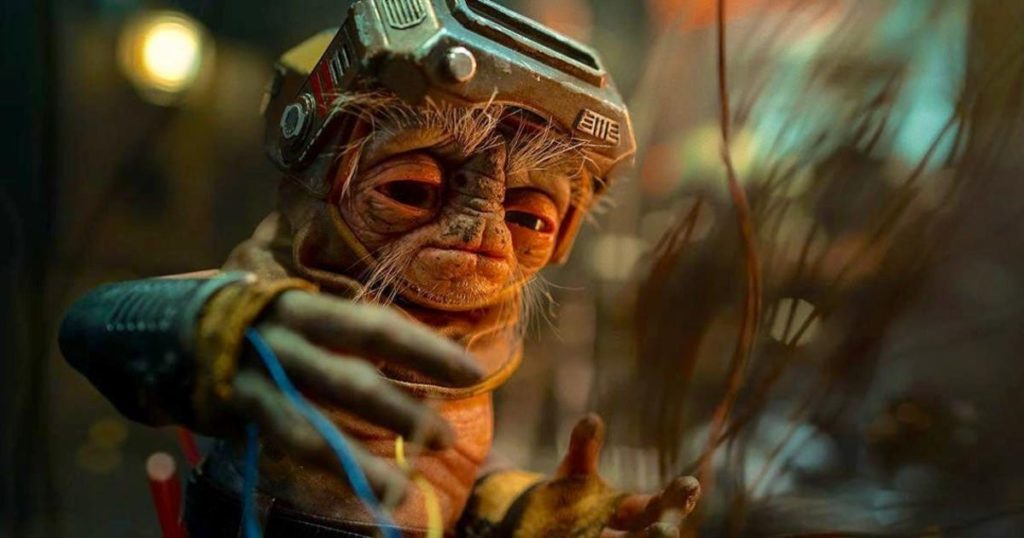
5) Babu Frik – One of the hardest things on a Star Wars production must be when you’ve put everything together and a character who you didn’t think much of at the time turns out to be an amazing breakout character, yet you don’t have the time left to expand their role. Babu Frik was that character in Episode 9. He was so fun. If you could’ve put him on the mission with the guys, he would’ve been comedic gold. Instead we get the giant packet of boring sauce that was Zori Bliss, who had about as much humor in her entire existence as Babu Frik had saying his name out loud. JJ’s ability to create these fun little characters was highly underrated (he did it with D-O as well).
4) BB8 – BB8 was Baby Yoda before Baby Yoda. I remember when I saw that famous Thanksgiving weekend trailer JJ surprised everyone with which featured that shot of this soccer-ball droid shooting across the desert landscape and thinking, “Oh my god. He’s done it! He’s given us a brand new Star Wars story!” It was so exciting. And it was one of the things in the original film that lived up to the trailer. The only thing I don’t like about BB-8 is that there isn’t a Saturday morning cartoon about him and Baby Yoda going on a road trip across the galaxy.
3) Jon Favreau – Jon Favreau is the guy Kathleen Kennedy needed from the start. If he was there giving her advice from the outset, we might’ve seen a completely different trilogy. But Favreau was not the force he was in the industry in 2015 and had to fight his way up through the Star Wars ranks, to get where he is now, which is unofficially running the TV side of the Star Wars universe. I don’t think Favreau is perfect. But he, all by himself, conceived of the first Star Wars character since the original trilogy that became part of the public zeitgeist, in Baby Yoda. For that choice alone, he’s gotta be near the top of the post-Lucas Star Wars rankings.
2) Kylo Ren – Behind that bundle of green joy, Kylo Ren is the biggest risk the post-Lucas franchise took. He’s this young whiney leader of the galaxy. It doesn’t make sense. But you know what they say about big risks? They have big payoffs. The unpredictability of the character brought something new and exciting to the Star Wars universe. We were used to Darth Vader, a guy who was structured and thoughtful about everything he did. Kylo was emotional and impulsive. I loved what that did for the series. It could be argued that Kylo Ren saved Star Wars. If they had gone with a more traditional villain, the trilogy might have been so boring that the franchise was permanently scarred. He’s such an interesting Star Wars character, Kylo. Also, JJ gets major major Star Wars points for casting Adam Driver.
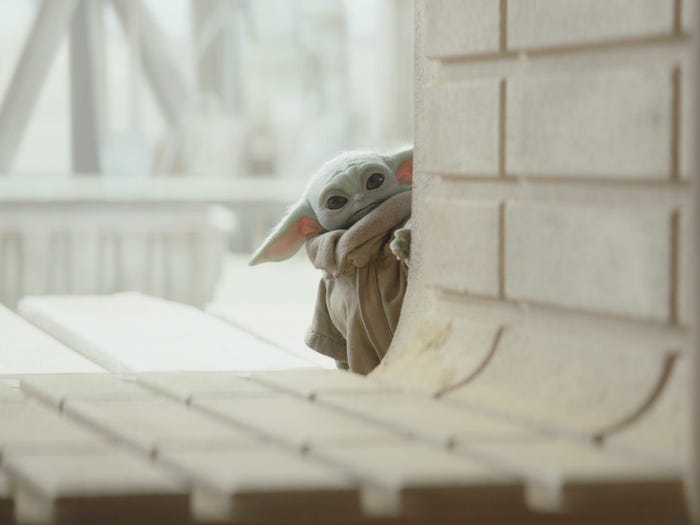
1) Baby Yoda – If there’s one thing everyone can agree on, it’s Baby Yoda. He’s just wonderful. And adorable. This is how I know this character is amazing. I have a friend who haaaaaa-aaates Star Wars. Hates it with every bone in her body. Yet *she* was sending me Baby Yoda memes during The Mandalorian’s run. Seeing Baby Yoda raise his little cute baby claw and channel the force to crush a giant robotic tank — the performance they’re able to get out of that little puppet warms my soul. It really does. It brings me back to the original Star Wars where everything was practical and that practicality contributed to making the universe feel real, because it was real! If you were on set, you could touch it. Favreau understood that. And it’s led to the best thing Star Wars has given us in decades.


